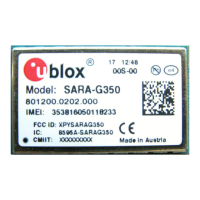SARA-G3 and SARA-U2 series - System Integration Manual
UBX-13000995 - R26 System description
Page 46 of 217
1.9.1 Asynchronous serial interface (UART)
1.9.1.1 UART features
The UART interface is a 9-wire 1.8 V unbalanced asynchronous serial interface available on all the SARA-G3 and
SARA-U2 series modules, supporting:
AT command mode
29
Data mode and Online command mode
29
Multiplexer protocol functionality (see 1.9.1.5)
FW upgrades by means of the FOAT feature (see 1.13.17)
FW upgrades by means of the u-blox EasyFlash tool (see the Firmware update application note [27])
Trace log capture (diagnostic purposes)
SARA-G3 modules do not support FW upgrades using the EasyFlash tool and trace log capture over UART.
SARA-G3 and SARA-U2 series modules’ UART interface is by default configured in AT command mode: the
module waits for AT command instructions and interprets all the characters received as commands to execute.
All the functionalities supported by SARA-G3 and SARA-U2 series modules can be in general set and configured
by AT commands (see the u-blox AT Commands Manual [3]).
The UART interface provides RS-232 functionality conforming to the ITU-T V.24 Recommendation (more details
available in ITU Recommendation [10]), with CMOS compatible signal levels: 0 V for low data bit or ON state,
and 1.8 V for high data bit or OFF state. For detailed electrical characteristics, see the SARA-G3 series Data
Sheet [1] and the SARA-U2 series Data Sheet [2].
SARA-G3 and SARA-U2 series modules are designed to operate as a 2G or 3G cellular modem, which represents
the Data Circuit-terminating Equipment (DCE) according to ITU-T V.24 Recommendation [10]. The application
processor connected to the module through the UART interface represents the Data Terminal Equipment (DTE).
The signal names of SARA-G3 and SARA-U2 series modules’ UART interface conform to the ITU-T V.24
Recommendation [10]: e.g. the TXD line represents the data transmitted by the DTE (application
processor data line output) and received by the DCE (module data line input).
All flow control handshakes are supported by the UART interface and can be set by appropriate AT commands
(see the u-blox AT Commands Manual [3], &K, +IFC, \Q AT commands): hardware, software, or none flow
control.
Hardware flow control is enabled by default.
SARA-G3 modules support the autobauding: the baud rate automatic detection is performed each time the DTE
sends AT commands. After the detection the module works at the detected baud rate and the baud rate can be
runtime changed by the DTE or by AT command (see the u-blox AT Commands Manual [3], +IPR command).
SARA-U2 modules support only the one-shot autobauding: the baud rate automatic detection is performed only
once, at module start-up. After the detection the module works at the detected baud rate and the baud rate can
only be changed by AT command (see the u-blox AT Commands Manual [3], +IPR command).
29
See the u-blox AT Commands Manual [3] for the definition of the command mode, data mode, and online command mode.

